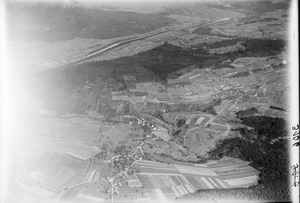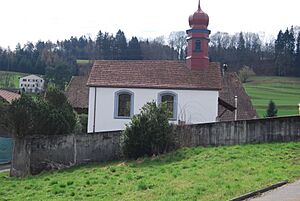Böbikon facts for kids
Quick facts for kids
Böbikon
|
||
|---|---|---|
 |
||
|
||
| Country | Switzerland | |
| Canton | Aargau | |
| District | Zurzach | |
| Area | ||
| • Total | 2.59 km2 (1.00 sq mi) | |
| Elevation | 444 m (1,457 ft) | |
| Population
(December 2020)
|
||
| • Total | 165 | |
| • Density | 63.71/km2 (165.0/sq mi) | |
| Postal code |
5334
|
|
| Surrounded by | Baldingen, Lengnau, Mellikon, Rekingen, Wislikofen | |
Böbikon is a small village in Switzerland. It used to be its own town (called a municipality). It is located in the Zurzach area of Canton Aargau. Böbikon is only about 2 kilometers (1.2 miles) south of the German border.
On January 1, 2022, Böbikon joined with several other nearby towns. These included Bad Zurzach, Baldingen, Kaiserstuhl, Rekingen, Rietheim, Rümikon, and Wislikofen. They all became part of the new, larger town of Zurzach.
Contents
History of Böbikon
Böbikon was first mentioned in records in the year 1113. It was originally a village settled by the Alamanni people. They cleared a space in the forest to build their homes. West of the village, you can find the remains of a small village that was lived in between 1100 and 1250.
Important landowners in the past included St. Blaisen Abbey and Zurzach Abbey. An abbey is like a monastery, a place where monks or nuns live. In the 1300s and 1400s, powerful families called the Lords of Liebegg had the right to hold courts here. Later, from 1506 to 1671, Sion Abbey in Klingnau held these rights. After that, private individuals owned them.
The village chapel, which is now a building from the 1700s, and the tithes (a part of people's earnings given to the church) first belonged to St. Blaisen Abbey. The village was part of the church area (called a parish) of Wislikofen. In 1883, Böbikon and its chapel became part of the new parish of Baldingen.
Even at the end of the 1900s, farming was the main way people made a living in Böbikon. In 1990, about three-quarters of all jobs in the village were in agriculture. This means most people worked on farms.
Geography of Böbikon
Böbikon covers an area of about 2.59 square kilometers (1 square mile). A big part of this land, about 55.2%, is used for farming. Forests cover about 38.2% of the area. The remaining 7.3% is where buildings and roads are located.
Most of the built-up area is made up of houses and other buildings (3.1%). Roads and other transport paths make up 4.2%. In the forested areas, 36.7% is dense forest. A small part, 1.5%, has orchards or small groups of trees. For farming, 35.5% of the land is used for growing crops. Another 15.4% is used for pastures where animals graze. About 4.2% is used for orchards or vineyards.
The village is in the Zurzach district. It sits in a forested valley between the Surbtal and the Rhine river. A stream called the Chrüzlibach flows through the village and the valley. Besides the main village of Böbikon, there are two tiny settlements called hamlets. Each hamlet has about a dozen people. These are Güggehü, about 500 meters (1,640 feet) north, and Rütihof, about 1,000 meters (3,280 feet) southwest. Böbikon is surrounded by other towns like Rekingen, Mellikon, Wislikofen, Lengnau, and Baldingen.
Coat of Arms
The coat of arms for Böbikon is blue. It has a silver half-mill wheel at the bottom. At the top, there is a golden star.
People of Böbikon (Demographics)
Böbikon has a population of about 170 people. As of June 2009, about 6% of the people living there were from other countries. Over ten years (from 1997 to 2007), the population grew by about 1.7%. Most people in Böbikon (98.9%) speak German. A small number speak Italian (0.5%) or English (0.5%).
Let's look at the age groups in Böbikon (as of 2008):
- Children (0-9 years old): 8.7%
- Teenagers (10-19 years old): 12.7%
- Young adults (20-29 years old): 12.1%
- Adults (30-39 years old): 5.8%
- Adults (40-49 years old): 20.8%
- Adults (50-59 years old): 16.2%
- Seniors (60-69 years old): 11.6%
- Seniors (70-79 years old): 7.5%
- Seniors (80-89 years old): 2.9%
- Seniors (90 and older): 1.7%
In 2000, the average home had 0.61 people per room. A "room" here means a space of at least 4 square meters (43 square feet), like bedrooms, living rooms, or kitchens. About 76.7% of homes were owned by the people living in them.
In 2000, there were 61 private homes in Böbikon. The average household had 3 people. In 2008, 33 homes (50%) were single-family houses. There were only 2 empty apartments, meaning most homes were occupied.
In the 2007 Swiss federal election, the most popular political party was the SVP. They received 54.87% of the votes. The next most popular parties were the CVP (22.78%), the FDP (8.21%), and the Green Party (7.23%). About 44.4% of eligible voters participated in this election.
Here is how the population of Böbikon has changed over time:
| Historical population | ||
|---|---|---|
| Year | Pop. | ±% |
| 1799 | 102 | — |
| 1850 | 269 | +163.7% |
| 1900 | 178 | −33.8% |
| 1950 | 159 | −10.7% |
| 1980 | 119 | −25.2% |
| 2000 | 183 | +53.8% |
Economy
In 2007, Böbikon had a low unemployment rate of 2.46%. This means most people who wanted to work had jobs.
In 2005, there were 32 people working in the primary economic sector. This means they worked in jobs like farming, fishing, or mining. There were 13 businesses in this area. Another 12 people worked in the secondary sector. These jobs involve making things, like in factories or construction. There were 4 businesses in this sector. Finally, 24 people worked in the tertiary sector. These are service jobs, like in shops, schools, or offices. There were 6 businesses in this sector.
In 2000, 99 people lived in Böbikon and worked. Most of them (62.6%) traveled outside Böbikon for their jobs. Only 8 people came into Böbikon to work. There were a total of 45 jobs in the village that were at least 6 hours per week. About 5.9% of workers used public transportation to get to work, while 46.1% used a private car.
Religion
Based on the 2000 census, most people in Böbikon were Christian. About 67.2% were Roman Catholic. Another 23.0% belonged to the Swiss Reformed Church. There was also 1 person who belonged to the Christian Catholic faith.
Education
Switzerland is known for its good education system. In Böbikon, about 78.5% of adults (aged 25-64) have finished either advanced high school or gone on to higher education, like university. In the 2008/2009 school year, 12 students attended primary school in the village.
See also
 In Spanish: Böbikon para niños
In Spanish: Böbikon para niños






